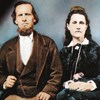
NPS Photo 
NPS Photo Bryce Canyon National Park lies on the eastern edge of the Paunsaugunt Plateau in south central Utah. Bryce Canyon National Monument (administered by the U.S. Forest Service) was originally established on June 8, 1923 to preserve the “unusual scenic beauty, scientific interest, and importance.” On June 7, 1924, the monument’s name was changed to Utah National Park and it was transferred to the National Park Service. On February 25, 1928 Utah National Park was changed to Bryce Canyon National Park. Subsequent legislation enlarged the park to its current size of 35,835 acres. Bryce is famous for its unique geology, consisting of a series of horseshoe-shaped amphitheaters carved from the eastern edge of the Paunsaugunt Plateau in southern Utah. The erosional force of frost-wedging and the dissolving power of rainwater have shaped the colorful calcium-rich mudstone of the Claron Formation into bizarre shapes including slot canyons, windows, fins, and spires called "hoodoos." Tinted with colors too numerous and subtle to name, these whimsically arranged rocks create a wondrous landscape of mazes, offering some of the most exciting and memorable walks and hikes imaginable. Ponderosa pines, high elevation meadows, and fir-spruce forests border the rim of the plateau and abound with wildlife. This area boasts some of the world's best air quality, offering panoramic views of three states and approaching 200 miles of visibility. This, coupled with the lack of nearby large light sources, creates unparalleled opportunities for stargazing. Historic Resource Study Follow this link to read Bryce Canyon's Historic Resource Study in its entirety. 
NPS Photo |
Last updated: June 18, 2018


